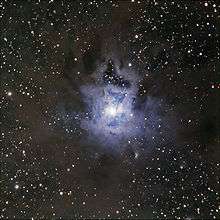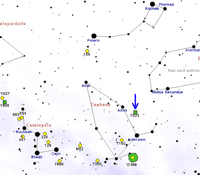Iris Nebula
The Iris Nebula (also known as NGC 7023 and Caldwell 4) is a bright reflection nebula in the constellation Cepheus. The designation NGC 7023 refers to the open cluster within the larger reflection nebula designated LBN 487.
| Reflection nebula | |
|---|---|
 Iris Nebula (NGC 7023 and LBN487) | |
| Observation data: J2000.0 epoch | |
| Right ascension | 21h 01m 35.60s |
| Declination | +68° 10′ 10.0" |
| Distance | 1,300 ly |
| Apparent magnitude (V) | 6.8 |
| Apparent dimensions (V) | 18' x 18' |
| Constellation | Cepheus |
| Physical characteristics | |
| Radius | 3 ly |
| Designations | NGC 7023 and LBN487, Caldwell 4, Cr 429 |
The nebula, which shines at magnitude +6.8, is illuminated by a magnitude +7.4 star designated SAO 19158.[1] It is located near the Mira-type variable star T Cephei, and near the bright magnitude +3.23 variable star Beta Cephei (Alphirk). It lies 1,300 light-years away and is six light-years across.[2]
Gallery
_by_G%C3%B6ran_Nilsson%2C_Hole_Observatory.jpg) RGB image of The Iris Nebula NGC 7023 taken with a 5" apochromatic refractor and a DSLR camera
RGB image of The Iris Nebula NGC 7023 taken with a 5" apochromatic refractor and a DSLR camera Map showing location of NGC 7023 (Roberto Mura)
Map showing location of NGC 7023 (Roberto Mura) captured at the Frog Island Observatory in Escanaba Mi in August 2019
captured at the Frog Island Observatory in Escanaba Mi in August 2019
Notes
- Perkins, Philip (2005). "NGC 7023". astrocruise.com. Archived from the original on 2008-05-18. Retrieved 2008-08-06.
- Nemiroff, R.; Bonnell, J., eds. (2004-11-04). "NGC 7023: The Iris Nebula". Astronomy Picture of the Day. NASA. Retrieved 2008-08-06.
gollark: Put devices in the walls which subliminally say "COMPUTER ENGINEERING" constantly.
gollark: bitcoin.avif > bitcoin.pdf
gollark: > posters on the wall is not a thing here<@341618941317349376> MAKE it a thing.
gollark: Your parents were not supportive enough so they reduced the value of cryptocurrency everywhere.
gollark: But what if crypto decreases in value‽
References
- Pasachoff, Jay M. (2000). "Atlas of the Sky". Stars and Planets. New York, New York: Peterson Field Guides. pp. 578 pg. ISBN 978-0-395-93432-6.
- Caldwell-Moore, Sir Patrick (2003). Firefly Atlas of the Universe. Firefly Books Limited. ISBN 978-1-55297-819-1.
External links
| Wikimedia Commons has media related to NGC 7023. |
- "NGC 7023". SIMBAD. Centre de données astronomiques de Strasbourg.
- SEDS – NGC 7023
- VizieR – NGC 7023
- NED – NGC 7023
- Dark Atmospheres Photography – Iris Nebula NGC 7023
- See NGC 7023 in WorldWide Telescope
- Iris Nebula on WikiSky: DSS2, SDSS, GALEX, IRAS, Hydrogen α, X-Ray, Astrophoto, Sky Map, Articles and images
This article is issued from Wikipedia. The text is licensed under Creative Commons - Attribution - Sharealike. Additional terms may apply for the media files.